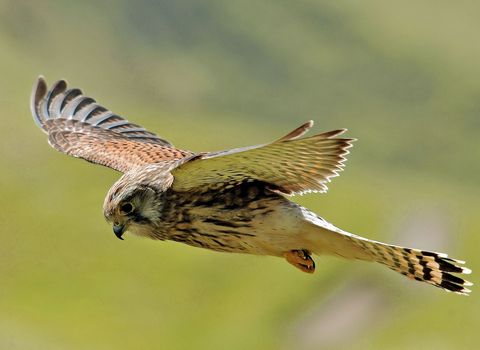
Kestrel © Jon Hawkins - Surrey Hills Photography
Kestrel
Scientific name
Falco tinnunculusWhen to see
January to DecemberSpecies information
Category
Statistics
Length: 33-39cmWingspan: 76cm
Weight: 190-220g
Average lifespan: 4 years
About
The kestrel is a little larger than a feral pigeon and can be found in all kinds of habitats, from open countryside to towns and villages. They nest in holes in trees, old buildings and abandoned crows' nests, laying between four and five eggs. When they hatch, both parents help to feed the young chicks.How to identify
Kestrels are typically seen hovering, their pointed wings held out. Males have a grey head and tail with a prominent black band, a gingery-brown back and a creamy underside which is speckled with black. Females are similar, but with a more uniform brown back and dark bands on the tail.Distribution
Widespread.In our area
Like in other parts of the world where kestrels live, their numbers in Shropshire fluctuate from year to year. During hard winters, large numbers die due to difficult hunting conditions. Kestrels need mice, voles and other small mammals to hunt throughout the year, so they have much higher survival rates during good years for vole populations.
Harvest time is often a good time to watch kestrels. When fields have been harvested for crops - particularly cereals like wheat and corn - small mammals lose their cover and are much easier for kestrels and other predators to spot.
They are an increasingly common sight at some of our nature reserves, particularly at Nipstone Rock and Mason's Bank, where they regularly hunt over the heathland.
Improvements to the management of roadside verges will play a key part in bring back kestrels across the wider landscape. Verges are usually left alone by humans for much of the year and act as refuges for lots of insects and small mammals. There are efforts being made to re-wild many verges in Shropshire, which will provide kestrels with increased productive hunting grounds.
Did you know?
The familiar behaviour of the kestrel gives it one of its old country names: the 'windhover'. The kestrel has the ability to keep its head still while it hovers - even in strong winds - helping it to pinpoint its prey by sight.Watch
Kestrel (https://vimeo.com/447526153/4b0b6f1ce5)
Kestrel by Russell Savory
Like in other parts of the world where kestrels live, their numbers in Shropshire fluctuate from year to year. During hard winters, large numbers die due to difficult hunting conditions. Kestrels need mice, voles and other small mammals to hunt throughout the year, so they have much higher survival rates during good years for vole populations.
Harvest time is often a good time to watch kestrels. When fields have been harvested for crops - particularly cereals like wheat and corn - small mammals lose their cover and are much easier for kestrels and other predators to spot.
They are an increasingly common sight at some of our nature reserves, particularly at Nipstone Rock and Mason's Bank, where they regularly hunt over the heathland.
Improvements to the management of roadside verges will play a key part in bring back kestrels across the wider landscape. Verges are usually left alone by humans for much of the year and act as refuges for lots of insects and small mammals. There are efforts being made to re-wild many verges in Shropshire, which will provide kestrels with increased productive hunting grounds.

